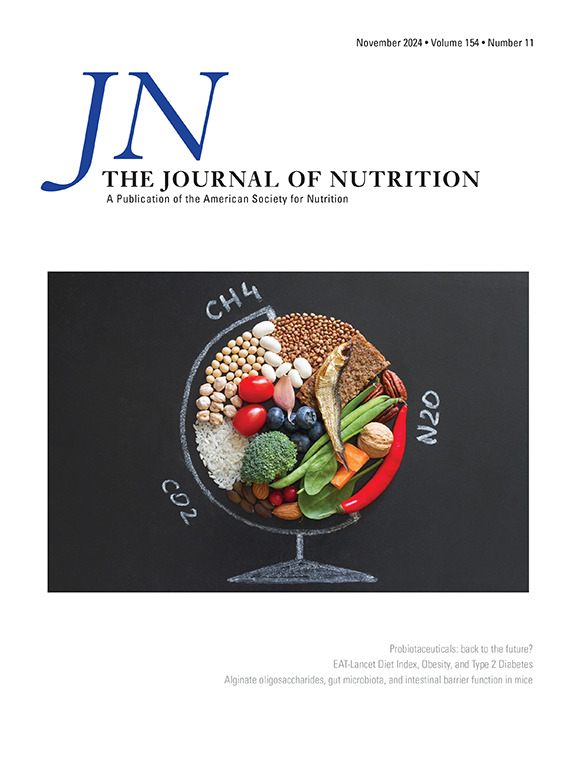健康饮食的成本:加拿大三种饮食成本方法的人口代表性比较。
IF 3.7
3区 医学
Q2 NUTRITION & DIETETICS
引用次数: 0
摘要
简介不同的食品价格来源和膳食评估工具可能会影响膳食成本的估算,并妨碍我们理解膳食成本与膳食摄入量之间的关系。在膳食评估保持一致的情况下,我们研究了三种膳食成本推导方法(食品价格数量和地理特异性不断增加)对总体和各食物组膳食成本估算的影响。方法我们将 2015 年加拿大社区健康调查-营养(CCHS-N)中的 24 小时膳食回忆数据与加拿大消费者价格指数(CPI)的三个食品价格清单(国家短清单、国家长清单和省级长清单)中的食品价格数据进行了比对。我们比较了整体人口(4 岁以上)、儿童(4-18 岁)和成人(19 岁以上)的每日饮食成本($/天)和能量调整后饮食成本($/2,000 千卡)。国家短清单导致的每日膳食成本和能量调整膳食成本总体最高。国家长清单和省级长清单的膳食成本没有差异。添加剂、甜食、水果和蔬菜这四类食物的膳食成本在国家短清单和省级长清单中存在显著差异。所有三种膳食成本法都与能量摄入量有明显相关性;但儿童的相关性较强/非常强,成人的相关性较弱/中等。改进膳食成本估算方法和衡量标准可以加强未来对消费者如何分配其购买的膳食的研究。本文章由计算机程序翻译,如有差异,请以英文原文为准。
Cost of a Healthy Diet: A Population-Representative Comparison of 3 Diet Cost Methods in Canada
Background
Different food price sources and dietary assessment tools may impact the estimation of diet costs and hamper our understanding of the relationship between diet costs and dietary intakes.
Objectives
We aimed to investigate the effect of 3 diet cost derivation methods, with increasing numbers of food prices and geographic specificity, holding consistent the dietary assessment tool, on the estimation of diet costs overall and by food group.
Methods
We matched 24-h dietary recall data from the 2015 Canadian Community Health Survey-Nutrition (CCHS-N) to food price data from 3 Canadian Consumer Price Index (CPI) food price lists; national short list, national long list, and provincial long list. We compared the daily ($/day) and energy-adjusted ($/2000 kcal) diet costs overall and by food groups for the overall population (4+), children (4–18), and adults (19+).
Results
The proportion of dietary intakes (grams) that were covered by CPI prices significantly increased from the national short list to the national long list but did not significantly differ from the national long list to the provincial long list. The national short list resulted in the highest daily and energy-adjusted diet costs overall. No difference in diet costs was noted between the national and provincial long lists. Diet costs for 4 food groups—additions, sweets, fruits, and vegetables, which were poorly covered by the national short list—significantly differed using the national and provincial long lists. All 3 diet cost methods were significantly correlated with energy intakes; however, a strong/very strong correlation was detected for children, and a weak/moderate correlation for adults.
Conclusions
The choice of food price data may introduce bias in the diet cost estimate, as well as limiting our understanding of how individuals allocate their diet costs. Refinement of diet cost estimation methodology and measures can strengthen future studies of how consumers allocate their purchases to their diets.
求助全文
通过发布文献求助,成功后即可免费获取论文全文。
去求助
来源期刊

Journal of Nutrition
医学-营养学
CiteScore
7.60
自引率
4.80%
发文量
260
审稿时长
39 days
期刊介绍:
The Journal of Nutrition (JN/J Nutr) publishes peer-reviewed original research papers covering all aspects of experimental nutrition in humans and other animal species; special articles such as reviews and biographies of prominent nutrition scientists; and issues, opinions, and commentaries on controversial issues in nutrition. Supplements are frequently published to provide extended discussion of topics of special interest.
 求助内容:
求助内容: 应助结果提醒方式:
应助结果提醒方式:


